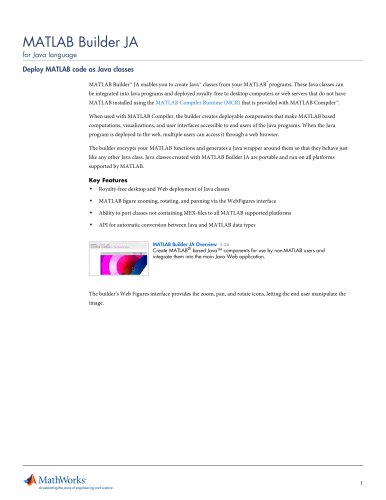
Catalog excerpts
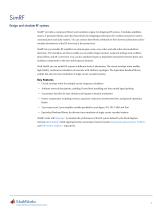
SimRF Design and simulate RF systems SimRF™ provides a component library and simulation engine for designing RF systems. It includes amplifiers, mixers, S-parameter blocks, and other basic blocks for designing architectures for wireless transceivers used in communication and radar systems. You can connect these blocks arbitrarily to form diverse architectures and to simulate the behavior of the RF front-end at the system level. SimRF lets you simulate RF amplifiers to estimate gain, noise, even-order, and odd-order intermodulation distortion. The simulation of mixers enables you to predict image rejection, reciprocal mixing, local oscillator phase offsets, and DC conversion. You can also simulate frequency-dependent mismatches between linear and nonlinear components in the time and frequency domains. With SimRF you can model RF systems at different levels of abstraction. The circuit envelope solver enables high-fidelity, multicarrier simulation of networks with arbitrary topologies. The Equivalent Baseband library enables fast, discrete-time simulation of single-carrier cascaded systems. Key Features ▪ Circuit envelope solver for multiple carrier-frequency simulation ▪ Arbitrary network descriptions, enabling N-port block modeling and intra-model signal probing ▪ S-parameter data files for time-domain and frequency-domain simulations ▪ Passive components, including resistors, capacitors, inductors, transmission lines, and general impedance blocks ▪ 3-port mixer and 2-port amplifier models specified by noise figure, IP2, IP3, P1dB, and Psat ▪ Equivalent Baseband library for discrete-time simulation of single-carrier cascaded systems SimRF works with Simscape™ to simulate the performance of the RF system defined by the block diagram. Gateways to Simulink® enable signal generation and analysis features found in Communications System Toolbox™ and DSP System Toolbox™, respectively.
Open the catalog to page 1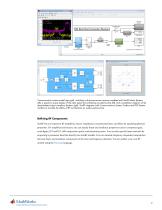
|lSM Band Direct Conversion Receiver! Communication system model (top right), including a direct-conversion receiver modeled with SimRF blocks (bottom left), a spectrum scope display of the input signal and interfering waveforms (top left), and constellation diagram of the demodulated output waveform (bottom right). SimRF integrates with Communications System Toolbox and DSP System Toolbox to simulate the effects of RF architectures on system performance. SimRF lets you represent RF amplifiers, mixers, impedances, transmission lines, and filters by specifying physical properties. For...
Open the catalog to page 2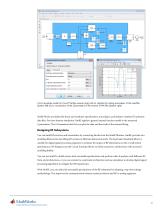
F i« Edit Vww Dup tsy Dug ram Simulation Analysis Code Tools r- \*b\ Blotk Parameters; IF Amplifrer Model 9 linear or nonlinear amplifier. Main Monlinearity Nonlinear polynomial type: Intercept points convention: 1-dB gain compression power: Output saturation power: Gain compression at saturation: ;r.r file Edit View insert Teeb Ceskics WirelD* Hfp Circuit envelope model of a low-!F Hartley receiver (top) with an interface for setting parameters of the amplifier (bottom left) and a visualization of the S-parameters of the receiver SAW filter (bottom right). SimRF blocks are defined by...
Open the catalog to page 3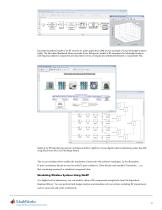
File Edit View tefftaf Owytm Smulftan tnttym Co* boh Help Equivalent baseband model of an RF receiver for radar applications (left) and an example of noise link-budget analysis (right). The Equivalent Baseband library provides 2-port behavioral models of RF subsystems for link-budget analysis, and frequency-selective components are described in terms of lumped and distributed elements or S-parameter files. Wfrelasrt □ Igllal video Broadcasting vdth RF BaamT«rrtng| Detail of an RF beamforming receiver architecture (bottom right) for a home digital audio broadcasting system (top left) using...
Open the catalog to page 4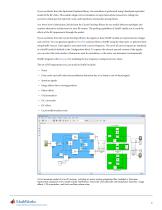
If you use blocks from the Equivalent Baseband library, the simulation is performed using a baseband equivalent model of the RF chain. This enables single-carrier simulation of super heterodyne transceivers, taking into account in-band spectral regrowth, noise, and impedance mismatches among blocks. At a lower level of abstraction, blocks from the Circuit Envelope library let you model arbitrary topologies and examine alternative architectures for your RF system. The probing capabilities of SimRF enable you to track the effects of the RF impairments through the model. If you use blocks from...
Open the catalog to page 5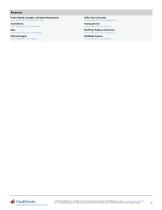
Product Details, Examples, and System Requirements Online User Community www.mathworks.com/products/simrf www.mathworks.com/matlabcentra Trial Software Training Services www.mathworks.com/trial request www.mathworks.com/training Sales Third-Party Products and Services www.mathworks.com/contactsales www.mathworks.com/connections Technical Support Worldwide Contacts www.mathworks.com/support www.mathworks.com/contact Accelerating the pace of engineering and science ©2013 The MathWorks, Inc. MATLAB and Simulink are registered trademarks of The MathWorks, Inc. See www.mathworks.com/trademarks...
Open the catalog to page 6All The MathWorks catalogs and technical brochures
-
MATLAB Production Server
6 Pages
-
Database Toolbox
4 Pages
-
MATLAB Report Generator
4 Pages
-
Stateflow
8 Pages
-
SimEvents
7 Pages
-
SimDriveline
7 Pages
-
SimHydraulics
7 Pages
-
SimPowerSystems
8 Pages
-
Simulink Control Design
5 Pages
-
Aerospace Blockset
5 Pages
-
Simulink Coder
6 Pages
-
Embedded Coder
8 Pages
-
Simulink PLC Coder
4 Pages
-
Fixed-Point Designer
9 Pages
-
MATLAB Coder
5 Pages
-
Simulink 3D Animation
10 Pages
-
Gauges Blockset
2 Pages
-
Simulink Report Generator
3 Pages
-
Polyspace Bug Finder
6 Pages
-
global-optimization-toolbox
10 Pages
-
Phased Array System Toolbox
9 Pages
-
OPC Toolbox
5 Pages
-
Simulink Design Verifier
7 Pages
-
Simulink Design Optimization
10 Pages
-
Filter Design HDL Coder
5 Pages
-
Bioinformatics Toolbox
9 Pages
-
SimBiology
6 Pages
-
Computer Vision System Toolbox
10 Pages
-
DSP System Toolbox
11 Pages
-
Fuzzy Logic Toolbox
5 Pages
-
Polyspace Client for C/C++
5 Pages
-
xPC Target
5 Pages
-
SimMechanics
7 Pages
-
Simscape
7 Pages
-
Simulink
6 Pages
-
Data Acquisition Toolbox
8 Pages
-
Image Processing Toolbox
7 Pages
-
Signal Processing Toolbox
10 Pages
-
Control System Toolbox
6 Pages
-
Symbolic Math Toolbox?
6 Pages
-
Parallel Computing Toolbox?
7 Pages
-
MATLAB®
6 Pages
-
Mapping Toolbox 3.2
7 Pages
-
Instrument Control Toolbox
7 Pages
-
Optimization Toolbox 6.0
14 Pages
Archived catalogs
-
MATLAB Release Notes
505 Pages
-
C and Fortran API Reference
263 Pages
-
External Interfaces
649 Pages
-
Function Reference: Volume 3 (P-Z)
1696 Pages
-
Function Reference: Volume 2 (F-O)
1568 Pages
-
Function Reference: Volume 1 (A-E)
1298 Pages
-
Creating Graphical User Interfaces
520 Pages
-
3-D Visualization
212 Pages
-
Graphics
667 Pages
-
MATLAB Programming Tips
66 Pages
-
Programming Fundamentals
840 Pages
-
Data Analysis
220 Pages
-
Mathematics
316 Pages
-
MATLAB® Getting Started Guide
250 Pages



